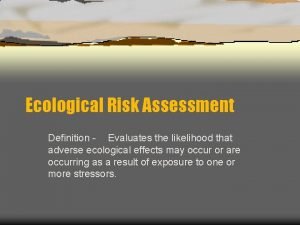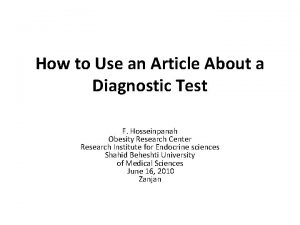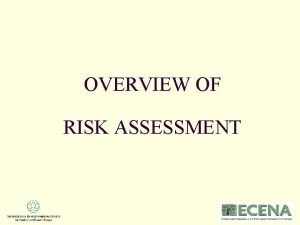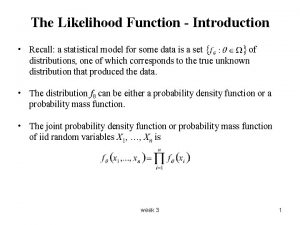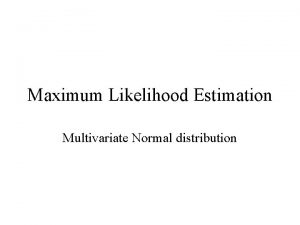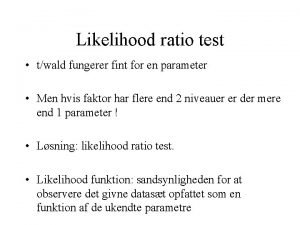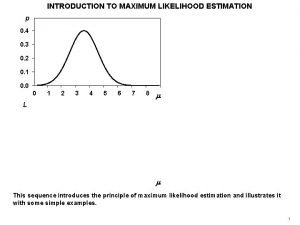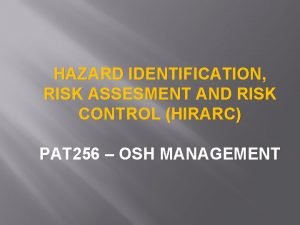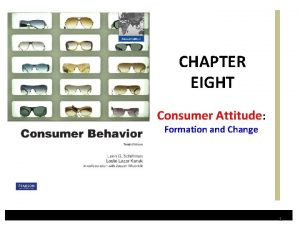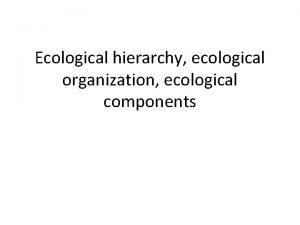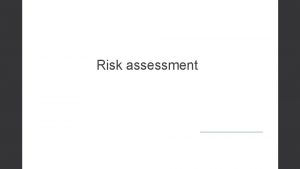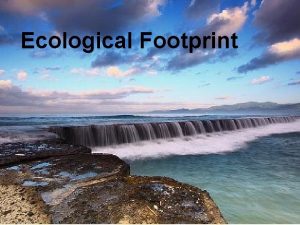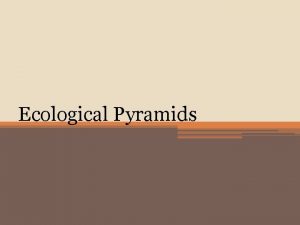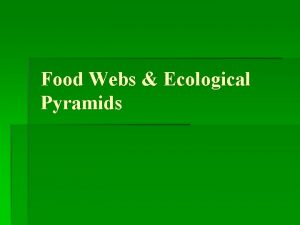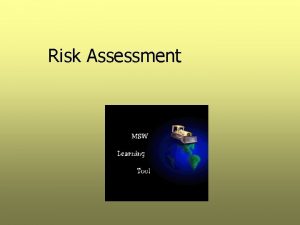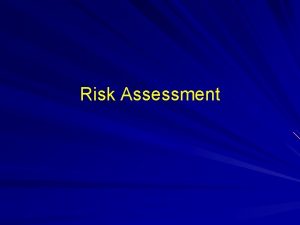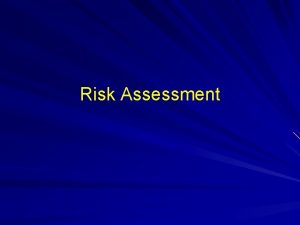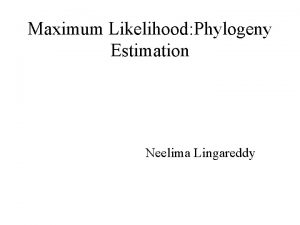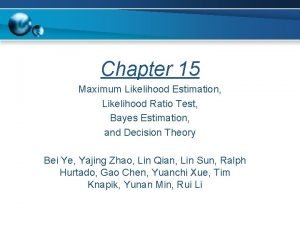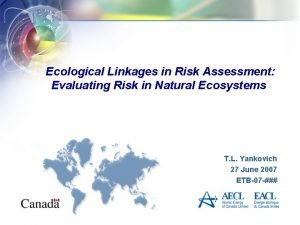Ecological Risk Assessment Definition Evaluates the likelihood that



























- Slides: 27

Ecological Risk Assessment Definition - Evaluates the likelihood that adverse ecological effects may occur or are occurring as a result of exposure to one or more stressors.

Legislation and Ecological Risk Ü NEPA Ü FIFRA Ü TSCA Ü FWPCA Ü CERCLA

Levels of Organization Ü Genetic Ü Bioaccumulation Ü Cell Ü Bioconcentration Ü Tissue Ü Biomagnification Ü Species-Individual Ü Population Ü Community Ü Ecosystem

Process Ü Ü Ü Ü Screening-level problem formulation and ecological effects eval. Screening-level exposure estimate and risk calculation* Baseline risk assessment, assessment endpoint selection Study design and DQO process* Verification of field sampling design Site investigation and data analysis Risk characterization Risk management*

Problem Formulation Ü Qualitatively evaluate contaminant release, migration, and fate Ü Identify: Contaminants of concern Receptors Complete exposure pathways Known effects Ü Endpoint selection Ü Develop conceptual model

Characterization of Contaminants Ü Documentation of all releases Volume Duration Release Mechanism Ü Routes of migration

Characterization of Contamination Ü Evaluate physiochemical properties Solubility Bioaccumulation potential Ü Mechanisms of pathways Spatial aspects Temporal aspects

Environmental Receptors Ü Characterize receptors Relevant species (e. g. endangered) Life history Feeding habits Habitat preference

Complete Exposure Pathways Ü Source Ü Route of exposure Ingestion Inhalation Dermal absorption Ü Exposure point Concentrations

Ecological Effects Assessment Ü Literature Ü Toxicity testing Ü Field studies

Assessment Endpoints ÜA formal expression of the actual environmental value to be protected Reduction of key population Disruption of community structure Ü Long-term persistence, abundance, or production of populations of significant species or ecological relevant habitats

Examples of Assessment Endpoints Ü Population- brown trout in reservoir Extinction Abundance Ü Communities- aquatic food web Market sport value Recreational quality Ü Ecosystems-entire reservoir Productivity or function

Measurement Endpoints ÜA physical, chemical, biological, or ecological condition that can be quantified Ü Measured in the laboratory or field Ü Must be associated with an assessment endpoint Ü Creates a method to meet the assessment endpoint that is quantifiable

Examples of Measurement Endpoints Ü Individual Death Melanomas Abnormal behavior Ü Population Occurrence Abundance Percent affected

Examples of Measurement Endpoints Ü Community Number of species Species diversity Ü Ecosystem Productivity Nutrient cycling

Developing a Conceptual Site Model Ü Receptors Ü Contaminant sources Ü Routes of exposure Ü Primary and secondary pathways Ü Contamination media

Analysis Phase of ERA Ü Determination of Ecological Effects Ecological Response Analysis/Ecotox Assessment Stressor response profile Effects linked to assessment endpoints Ü Characterization of Ecological Exposure pathways Receptor characteristics Exposure concentrations

Contribution of Toxicity Tests in ERA Ü Bioavailability of stressors Ü Aggregate toxic effects for all stressors Ü Development of new toxicity information Ü Characterization of nature of toxic effect Ü Distribution of toxicity Ü Biomonitoring

Toxicity Tests used in ERAs Ü Freshwater Aquatic and Sediment Tests Daphnia, minnow, algae, amphipod or midge Ü Marine and Estuarine Tests Sheepshead minnow, silverside, mysid shrimp Ü Terrestrial Tests Earthworm, collembola, seed germination and root elongation, growth on rooted plants, FETAX (Frog embryo teratogenesis assay), avian toxicity tests

Toxicological Endpoints Ü NOAEL = No observable adverse effect level Ü LOAEL Ü LD 50, LC 50, EC or ED, effective conc or dose

Endpoints with Chronic testing Ü Growth Ü Reproduction Ü Nerve function impairment Ü Immobility or behavioral changes Ü Development of morphological abnormalities

In-situ Toxicity Tests Ü Expose test organisms on-site Ü Measures bioavailability Ü Organisms are exposed to natural stressors Ü Uncontrolled environment

Analysis Phase Characterization of Receptors Ü Life History Ü Feeding habits, Diet, and Food sources Ü Habitat Preferences Ü Energy Requirements, Physiological and Metabolic pathways Ü Pathway analysis and/or food chain

Ecological effects and exposure Ü Stressor Response Ü Characterize the Analysis receptors Ü Link effects, dose, or Ü Determine exposure toxicity value to routes and pathways endangered species Ü Measure or estimate exposure point conc.

Risk Characterization Ü Final step Ü Integration process Ü Estimation of risk- quantitative or qualitative Hazard quotient Probabilistic risk estimates Weight of evidence Ü Should include an Uncertainty Analysis

Hazard Quotient Method Ü Provides a point estimate and relates stressor concentrations with effects levels Ü Hazard Quotient (HQ) = EEC/ TEC Expected Exposure Conc. TEC Toxicological Endpoint Conc. (NOAEL or LD 50)

Hazard Quotient Method Ü Represents ratio of safe to unsafe exposure Ü If HQ exceeds unity, toxicity threshold is exceeded an adverse toxicological effects is expected Ü Multiple stressors can be summed for same pathways to determine an Hazard Index (HI) Ü Range of HQs or HIs
 Supply chain cisco
Supply chain cisco Evaluates definition
Evaluates definition Identifies, selects, monitors, and evaluates sales channels
Identifies, selects, monitors, and evaluates sales channels The aspire test helps to measure and career readiness
The aspire test helps to measure and career readiness Credit risk market risk operational risk
Credit risk market risk operational risk Phân độ lown ngoại tâm thu
Phân độ lown ngoại tâm thu Premature atrial contraction
Premature atrial contraction Thể thơ truyền thống
Thể thơ truyền thống Thơ thất ngôn tứ tuyệt đường luật
Thơ thất ngôn tứ tuyệt đường luật Chiến lược kinh doanh quốc tế của walmart
Chiến lược kinh doanh quốc tế của walmart Tìm vết của đường thẳng
Tìm vết của đường thẳng Hãy nói thật ít để làm được nhiều
Hãy nói thật ít để làm được nhiều Tôn thất thuyết là ai
Tôn thất thuyết là ai Gây tê cơ vuông thắt lưng
Gây tê cơ vuông thắt lưng Sau thất bại ở hồ điển triệt
Sau thất bại ở hồ điển triệt Negative likelihood ratio
Negative likelihood ratio Ecological risk assesment
Ecological risk assesment Dynamic risk assessment definition
Dynamic risk assessment definition Risk assessment definition
Risk assessment definition Likelihood function
Likelihood function The likelihood that an event will occur.
The likelihood that an event will occur. Mle formula
Mle formula Maximum likelihood estimator variance
Maximum likelihood estimator variance Twald
Twald Maximum likelihood estimator variance
Maximum likelihood estimator variance Example of hirac
Example of hirac Maximum parsimony vs maximum likelihood
Maximum parsimony vs maximum likelihood Elaboration likelihood theory
Elaboration likelihood theory

